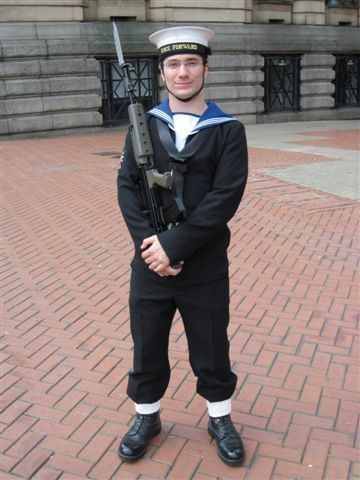 | ||
A sailor suit is a uniform traditionally worn by enlisted seamen in the navy, and other government funded sea services. It later developed into a popular clothing style for children, especially as dress clothes.
Contents
Origins and history
In the Royal Navy, the sailor suit or naval rig is known as Number One uniform and is worn by Able Rates and Leading Hands. It is primarily ceremonial, although it dates from the old working rigs of Royal Navy sailors which has changed continuously since its first introduction in 1857.
The blue jean collar is perhaps the most recognisable item of the sailor suit, and tradition says that it dates from the times when seamen wore tarred pigtails. This is in fact false, as the collar was not part of uniform until after pigtails disappeared. The three stripes have nothing to do with Nelson's three victories but was simply standardised to three when uniform was regulated. It is often considered lucky to touch a sailor's collar.
The bell bottomed trousers were designed so that they could be rolled up easily when scrubbing the decks. Ratings used to have either five or seven horizontal creases and this did not represent the seven seas or five oceans but depended on the length of the sailor's leg.
The lanyard was originally used to carry the hornpipe.
In the United States, the first standard uniform was issued in 1817. Through government procurement, winter and summer uniforms were provided. White duck jacket, trousers and vest made up the summer uniform, while the winter uniform consisted of a blue jacket and trousers, red vest with yellow buttons and a black hat.
Sailor suits were also worn by sailors in the Royal Canadian Navy and disappeared in 1968 when the Canadian Forces was established and uniforms were standardized for the unified forces.
As children's clothing
In 1846, the four-year-old Albert Edward, Prince of Wales was given a scaled-down version of the uniform worn by ratings on the Royal Yacht. He wore his miniature sailor suit during a cruise off the Channel Islands that September, delighting his mother and the public. Popular engravings, including the famous portrait done by Winterhalter, spread the idea, and by the 1870s, the sailor suit had become normal dress for both boys and girls all over the world. Some Western cartoon and comic characters use a sailor suit as their trademarks; examples include Popeye, Donald Duck and Spoilt Bastard. Sailor suits have been worn by the members of the Vienna Boy's Choir on their international tours.
A female version of the sailor suit, the sailor dress, was popularly known in early 20th century America as a Peter Thomson dress in the early 20th century after a naval tailor based in New York and Philadelphia.
When doing the Sailor's Hornpipe dance, a Highland character dancer is required to wear a sailor suit.
Sailor school uniform in Asia
Many schools in some Asian countries, typically in Japan, Taiwan, North Korea, South Korea, Hong Kong, Singapore and Thailand, have adopted sailor outfits as a school uniform.
Japan
Sailor suits are especially common in Japanese girls' schools, known as sailor fuku by the Japanese. They are so common that the image of the outfit has evolved to be strongly associated with youth and female adolescence in popular culture. As a result, sailor uniform are seen very frequently in Japanese teen dramas, movies, anime, manga, music videos and concert performances of pop teen idol groups' (notably by Hello! Project, AKB48, Nogizaka46, and Onyanko Club).
